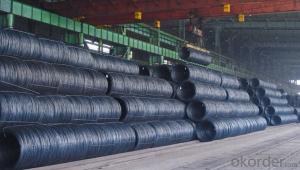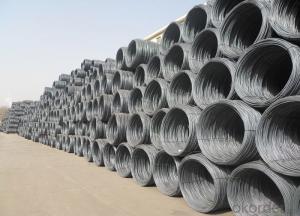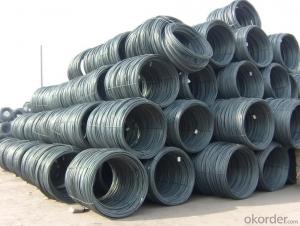Prime Hot Rolled Alloy Steel Wire Rods in Coil
- Loading Port:
- China main port
- Payment Terms:
- TT OR LC
- Min Order Qty:
- 100 m.t.
- Supply Capability:
- 10000 m.t./month
OKorder Service Pledge
OKorder Financial Service
You Might Also Like
Product Description:
OKorder is offering Prime Hot Rolled Alloy Steel Wire Rods in Coil at great prices with worldwide shipping. Our supplier is a world-class manufacturer of steel, with our products utilized the world over. OKorder annually supplies products to African, South American and Asian markets. We provide quotations within 24 hours of receiving an inquiry and guarantee competitive prices.
Product Applications:
Prime Hot Rolled Alloy Steel Wire Rods in Coil are ideal for structural applications and are widely used in construction and manufacturing. Carbon steel wire rod is mainly used for reinforcement of reinforced concrete and welded structure or reprocessed (roberts , nail, etc.) materials, especially used to produce wire drawing, welding electrode, nails, spring, electronic, precise machinery parts and so on.
Product Advantages:
OKorder's Prime Hot Rolled Alloy Steel Wire Rods in Coil are durable, strong, and wide variety of sizes.
Main Product Features:
· Premium quality
· Prompt delivery & seaworthy packing (30 days after receiving deposit)
· Can be recycled and reused
· Mill test certification
· Professional Service
· Competitive pricing
Product Specifications:
Steel Grade: SAE1006-1018B
Standard: ASTM, GB
Diameter: 5.5mm, 6.5mm, 7mm,8mm,9mm,10mm,12mm,14mm
Type: in coil, coil weight around 2MT
Alloy or Not: Alloy
Technique: Hot Rolled
Place of Origin: China Mainland
Surface: round, no twisted, light and smooth
FAQ:
Q1: Why buy Materials & Equipment from OKorder.com?
A1: All products offered byOKorder.com are carefully selected from China's most reliable manufacturing enterprises. Through its ISO certifications, OKorder.com adheres to the highest standards and a commitment to supply chain safety and customer satisfaction.
Q2: How do we guarantee the quality of our products?
A2: We have established an advanced quality management system which conducts strict quality tests at every step, from raw materials to the final product. At the same time, we provide extensive follow-up service assurances as required.
Q3: How soon can we receive the product after purchase?
A3: Within three days of placing an order, we will arrange production. The normal sizes with the normal grade can be produced within one month. The specific shipping date is dependent upon international and government factors, the delivery to international main port about 45-60days.
Images:
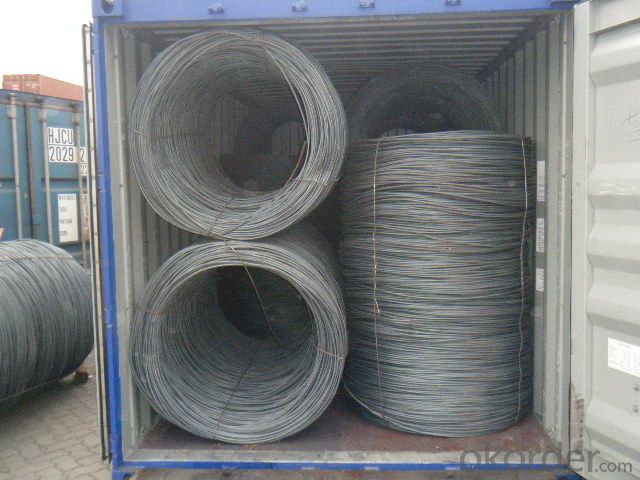
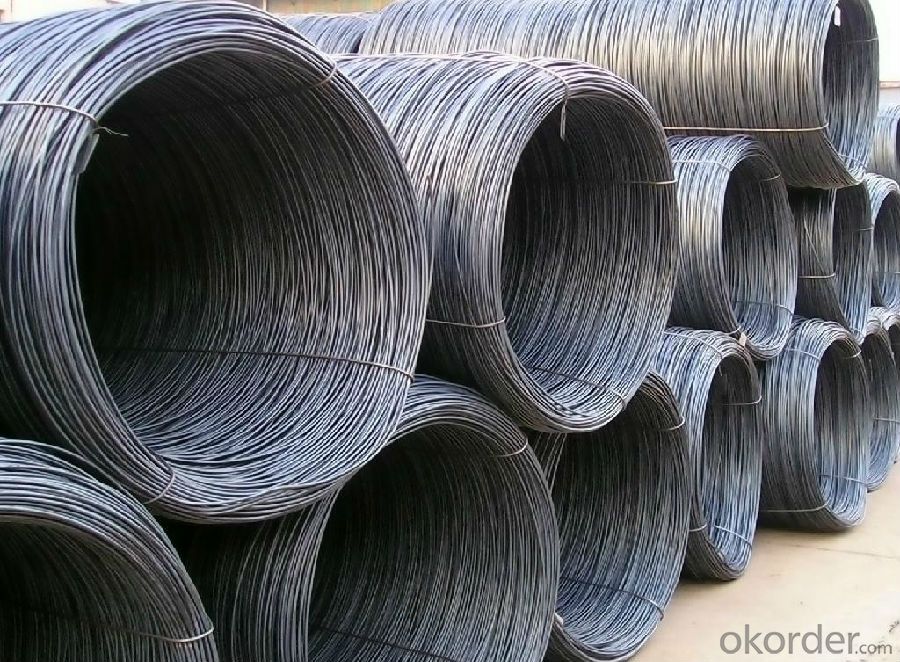
- Q:How is steel wire rod inspected for surface defects?
- The process of inspecting steel wire rods for surface defects involves two main methods: visual inspection and non-destructive testing. Trained personnel carry out the visual inspection, carefully examining the surface of the wire rod for any visible defects such as scratches, cracks, pits, or deformations. To ensure a thorough detection, proper lighting and magnifying tools are used. In addition to visual inspection, non-destructive testing techniques are used to further assess the quality of the wire rod. One commonly used method is magnetic particle inspection, where the wire rod is magnetized and a magnetic particle solution is applied on its surface. If there are any surface defects like cracks or discontinuities, the magnetic particles will cluster together, making the defect visible. Another method employed is ultrasonic testing, which involves transmitting high-frequency sound waves through the wire rod. Any internal or external defects will reflect these waves back, enabling the inspector to detect and measure the size and depth of the defects. Furthermore, eddy current testing is another non-destructive technique utilized for surface inspection. This method involves inducing an electric current in the wire rod and measuring the resulting magnetic field. Any surface defects will cause changes in the magnetic field, which can then be detected by the inspection equipment. Overall, a combination of visual inspection and non-destructive testing methods is used to ensure that steel wire rods undergo a thorough inspection for surface defects. This ensures that consumers receive a reliable and high-quality product.
- Q:What are the main factors influencing the choice of steel wire rod order frequency?
- The main factors influencing the choice of steel wire rod order frequency typically include market demand, inventory levels, production capacity, lead time, and cost considerations.
- Q:What are the different packaging materials used for steel wire rod?
- Packaging materials for steel wire rods vary based on factors such as length, weight, protection needed during transportation, and ease of handling. Commonly used materials include steel coils, wooden reels, pallets, cardboard boxes, and plastic wraps. Steel coils are a popular option, as they provide compact and secure packaging that is easy to transport and handle. For longer and heavier wire rods, wooden reels offer a larger and more stable packaging solution, commonly used in construction and industrial applications. Pallets are another option, providing a stable base for wire rods and enabling easy handling with forklifts or pallet jacks. Cardboard boxes are suitable for smaller or specific length wire rods, offering protection during transportation and facilitating storage. In some cases, plastic wraps are used for steel wire rods, particularly when smaller quantities need protection from moisture or dust during transportation. It should be noted that the choice of packaging material depends on the specific requirements of the manufacturer and end user, as well as factors like cost, transportation method, and storage conditions.
- Q:How is steel wire rod used in the manufacturing of barbed wire?
- Steel wire rod is a key component in the manufacturing process of barbed wire. It is used as the primary material to create the barbs and the twisted strands that make up the final product. The steel wire rod is first drawn into thinner wires, which are then twisted together to form the strands of the barbed wire. These strands are then further twisted together with sharp barbs attached at regular intervals to create the characteristic barbed wire structure. The strength and durability of steel wire rod make it an ideal material for barbed wire, as it can withstand the tension and pressure that the wire may be subjected to, while also providing the necessary sharpness and rigidity for effective fencing and security purposes. Overall, steel wire rod plays a crucial role in the manufacturing process of barbed wire, providing the necessary strength, durability, and functionality to the end product.
- Q:How are steel wire rods used in the production of electrical wires for conducting electricity?
- Steel wire rods are used in the production of electrical wires as the core material for conducting electricity. The rods are drawn through a series of dies to reduce their diameter and increase their length. This process, known as wire drawing, creates a smooth and uniform wire that is then coated with an insulating material, such as PVC or rubber, to ensure electrical safety. The resulting electrical wire is flexible, durable, and capable of efficiently transmitting electricity without any significant loss.
- Q:How is steel wire rod used in the manufacturing of wire for power generation systems?
- Steel wire rod is a crucial component in the manufacturing of wire for power generation systems as it serves as the raw material used to produce high-quality wires. These wires are then utilized in various applications within power generation systems, such as electrical transmission lines, cables, and conductors. The strength, durability, and conductivity of steel wire rod make it ideal for ensuring efficient power transmission and reliable performance in these systems.
- Q:How are steel wire rods used in the production of bicycle spokes?
- Steel wire rods are an essential component in the production of bicycle spokes. These rods are typically made from high-quality steel, ensuring strength and durability. The manufacturing process begins with the wire rods being fed into a machine that straightens and cuts them to the required length for spokes. Once the wire rods are cut, they are further processed to create the desired shape. This is typically done by passing the rods through a machine that forms them into a "J-bend" shape, which is necessary for attaching the spokes to the bicycle hub and rim. After the rods are shaped, they are often subjected to a heat treatment process to enhance their strength and resilience. This process, known as annealing, involves heating the rods to a specific temperature and then slowly cooling them. Annealing helps to remove any internal stresses and improve the overall mechanical properties of the spokes. Next, the spokes are typically galvanized or coated with a protective layer to prevent corrosion. This coating not only enhances the appearance of the spokes but also increases their lifespan by providing resistance against rust and other forms of deterioration. Finally, the spokes are ready to be assembled into the bicycle wheel. They are inserted into the hub and threaded through the rim, forming a pattern that ensures optimal strength and stability. The spokes are then tightened to the appropriate tension, ensuring the wheel is properly aligned and balanced. In summary, steel wire rods play a crucial role in the production of bicycle spokes. They are used to create the necessary shape and strength, undergo heat treatment processes, and are coated to enhance their durability. Ultimately, the quality of the wire rods used greatly influences the performance and longevity of bicycle spokes.
- Q:What are the different grades of steel wire rod?
- There are several different grades of steel wire rod, including low carbon, medium carbon, high carbon, and alloy steel grades.
- Q:What are the different types of steel wire rod surface treatment methods?
- There are several different types of steel wire rod surface treatment methods that are commonly used in various industries. These methods are employed to enhance the properties of the steel wire rod and ensure its durability and longevity. Some of the most common surface treatment methods for steel wire rod include: 1. Pickling: This method involves immersing the steel wire rod in an acid solution, typically hydrochloric or sulfuric acid, to remove scale, rust, and other impurities from the surface. Pickling helps to improve the overall appearance and cleanliness of the wire rod. 2. Coating: Coating the steel wire rod with a protective layer is another popular surface treatment method. This can be done through processes like galvanizing, where the wire rod is coated with a layer of zinc to prevent corrosion and improve its resistance to wear and tear. Other coating methods include epoxy, polymer, or ceramic coating, which offer additional protection against environmental factors. 3. Heat treatment: Heat treatment is a process that involves subjecting the steel wire rod to controlled heating and cooling cycles to alter its microstructure and improve its mechanical properties. This treatment method can include processes like annealing, normalizing, or quenching and tempering, which enhance the wire rod's strength, hardness, and ductility. 4. Surface passivation: Passivation is a chemical process that is used to remove free iron and other contaminants from the surface of the steel wire rod. This treatment method helps to promote the formation of a passive oxide layer, which acts as a protective barrier against corrosion. 5. Shot peening: Shot peening is a mechanical surface treatment method that involves bombarding the steel wire rod with small spherical particles, known as shot, at high velocities. This process induces compressive stresses in the surface layer of the wire rod, improving its fatigue strength and resistance to stress corrosion cracking. Overall, these different types of surface treatment methods for steel wire rod play a crucial role in enhancing its performance, durability, and resistance to various environmental factors. The choice of treatment method largely depends on the specific requirements of the industry and the intended application of the wire rod.
- Q:How is steel wire rod used in the manufacturing of wire for safety barriers on highways?
- Steel wire rod is used in the manufacturing of wire for safety barriers on highways as it serves as the primary raw material. The wire rod is first processed and shaped into the desired gauge and dimensions, and then it is further treated to enhance its strength and durability. This processed wire is then woven or welded into the specific patterns required for safety barriers, creating a strong and reliable barrier system that can effectively prevent vehicles from crossing into opposing traffic or off the road.
1. Manufacturer Overview |
|
|---|---|
| Location | |
| Year Established | |
| Annual Output Value | |
| Main Markets | |
| Company Certifications | |
2. Manufacturer Certificates |
|
|---|---|
| a) Certification Name | |
| Range | |
| Reference | |
| Validity Period | |
3. Manufacturer Capability |
|
|---|---|
| a)Trade Capacity | |
| Nearest Port | |
| Export Percentage | |
| No.of Employees in Trade Department | |
| Language Spoken: | |
| b)Factory Information | |
| Factory Size: | |
| No. of Production Lines | |
| Contract Manufacturing | |
| Product Price Range | |
Send your message to us
Prime Hot Rolled Alloy Steel Wire Rods in Coil
- Loading Port:
- China main port
- Payment Terms:
- TT OR LC
- Min Order Qty:
- 100 m.t.
- Supply Capability:
- 10000 m.t./month
OKorder Service Pledge
OKorder Financial Service
Similar products
New products
Hot products
Related keywords
